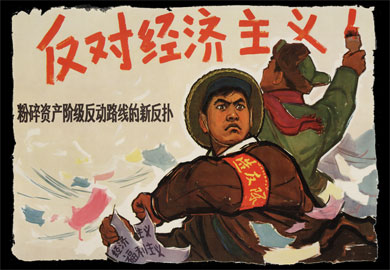Revolutionary Art
The visual motif of The Revolutionary is built on the rich body of Chinese revolutionary art. Most of the pieces used in the film were acquired from The International Institute of Social History in Amsterdam. Below you can look through some of the more important posters.
Advance under the Banner of Mao Zedong

This 1949 poster depicts Mao as the revolutionary military leader. It commemorates the 12th anniversary of the start of the war with Japan where the Communists, led by Mao Zedong, and the Nationalists, led by Chiang Kai-shek, maintained an uneasy truce while fighting a common enemy.
The Foreign Expert

During the 1950s, China received the help of many outside "experts" mostly from the Soviet Union. Sidney Rittenberg was one of the few experts to come from the United States.
Put Organizations On A Military Footing, Put Actions On A War Footing, Put Life On A Collective Footing

This 1959 poster depicts the call to action for the Great Leap Forward, particularly the collectivization that occurred at that time.
Bombard the Headquarters

From the inception of the Cultural Revolution, the big character poster played a pivotal role. This poster commemorates Mao's famous big character poster in which he called for the new revolutionaries to turn on the Chinese Communist Party, leading to an increase in chaos and violence in the country.
Criticize the Old World and Build a New World with Mao Zedong Thought as a Weapon
The Little Red Book of Mao's quotations was ubiquitous during the Cultural Revolution. It was interpreted in many ways, and only Mao was the authority to what was correct.
Fully Carry out the Revolution on the Thought and Culture Struggle Line
The Cultural Revolution was fueled by the ideological fervor of young Chinese. This poster depicts the intensity of the time, but doesn't come close to revealing the extraordinary violence that occurred.
The Invincible Thought of Mao Zedong Illuminates the Stage of Revolutionary Art!
Mao's wife, Jiang Qing, was a former movie actress and promoted the arts. But during the Cultural Revolution she became prominent in politics as a member of the Gang of Four, and a nemesis of Sidney Rittenberg, finally causing him to be thrown into prison.





